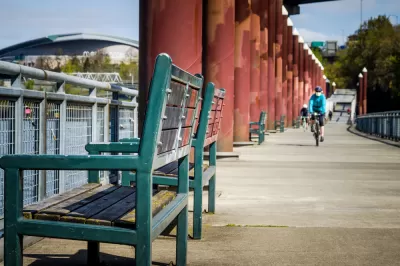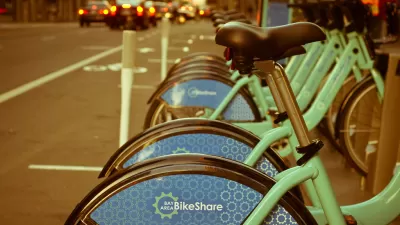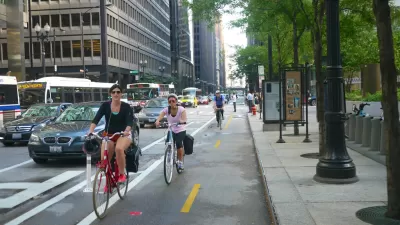"Anytime the city does something to dramatically improve streets for people and limit car access...it’s hard to take them back."

Kristian Foden-Vencil reports on the ongoing bike boom in Portland, and its likelihood of persisting beyond the pandemic.
The story is obviously focused on Portland's unique culture, where a bike boom is measured in group rides focused on Pickles, Star Trek, crossing bridges, and being naked. But, there have been more run-of-the-mill signs of biking's popularity during the pandemic:
At the height of the pandemic, the streets were so full of bikes, the city had to do something. It launched a ‘Slow Streets’ program and put plastic bollards and signs across 100 miles of streets to make them bike and pedestrian-friendly.
While an official count is "elusive," according to the article, Foden-Vencil cites Bike Portland editor Jonathan Maus to make the case that the bike boom is likely to stick around in Portland.
“Anytime the city does something to dramatically improve streets for people and limit car access...it’s hard to take them back because, guess what, people love having a healthier quieter, more humane way to get around,” Maus said.
While the Oregon Department of Transportation recently announced $55 million in funding for pedestrian and bike infrastructure, and the "Infrastructure Investment and Jobs Act" recently passed by the Senate could include big sums of money for bike infrastructure if it achieves full approval in the House, Maus also argues that it will take more than money for bikes to help significant numbers of people ditch cars for bikes—it will also take less spending on car infrastructure (an orientation that the Oregon Department of Transportation hasn't yet abandoned, despite its $55 million promise).
FULL STORY: Will the bicycling boom survive after the pandemic?

Maui's Vacation Rental Debate Turns Ugly
Verbal attacks, misinformation campaigns and fistfights plague a high-stakes debate to convert thousands of vacation rentals into long-term housing.

Planetizen Federal Action Tracker
A weekly monitor of how Trump’s orders and actions are impacting planners and planning in America.

San Francisco Suspends Traffic Calming Amidst Record Deaths
Citing “a challenging fiscal landscape,” the city will cease the program on the heels of 42 traffic deaths, including 24 pedestrians.

Defunct Pittsburgh Power Plant to Become Residential Tower
A decommissioned steam heat plant will be redeveloped into almost 100 affordable housing units.

Trump Prompts Restructuring of Transportation Research Board in “Unprecedented Overreach”
The TRB has eliminated more than half of its committees including those focused on climate, equity, and cities.

Amtrak Rolls Out New Orleans to Alabama “Mardi Gras” Train
The new service will operate morning and evening departures between Mobile and New Orleans.
Urban Design for Planners 1: Software Tools
This six-course series explores essential urban design concepts using open source software and equips planners with the tools they need to participate fully in the urban design process.
Planning for Universal Design
Learn the tools for implementing Universal Design in planning regulations.
Heyer Gruel & Associates PA
JM Goldson LLC
Custer County Colorado
City of Camden Redevelopment Agency
City of Astoria
Transportation Research & Education Center (TREC) at Portland State University
Jefferson Parish Government
Camden Redevelopment Agency
City of Claremont





























